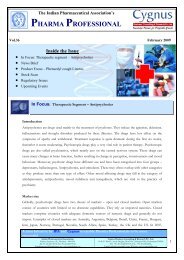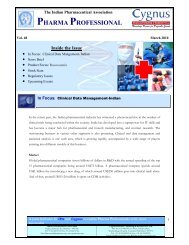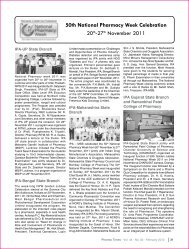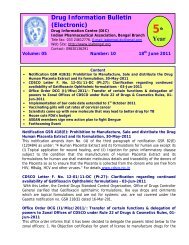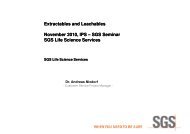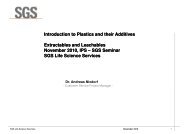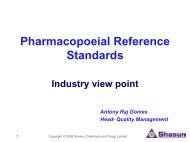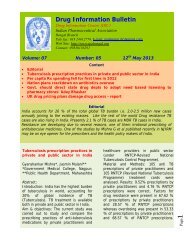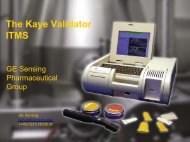Presentation of DR Sandip Tiwari
Presentation of DR Sandip Tiwari
Presentation of DR Sandip Tiwari
You also want an ePaper? Increase the reach of your titles
YUMPU automatically turns print PDFs into web optimized ePapers that Google loves.
Adopting Technologies to Enhance Quality in<br />
Manufacturing<br />
<strong>Sandip</strong> B. <strong>Tiwari</strong>, Ph.D.<br />
March 18, 2012
Current Status <strong>of</strong> Quality in Pharma Manufacturing<br />
“Pharmaceutical manufacturing<br />
techniques lag behind those <strong>of</strong><br />
potato-chip and laundry soap<br />
makers.”<br />
The Wall Street Journal, September 3, 2003
Outline<br />
• What is Quality in Pharmaceutical Manufacturing<br />
• Assurance <strong>of</strong> Quality: Changing Paradigm<br />
• Quality by Testing (QbT) to Quality by Design (QbD)<br />
• What is QbD<br />
• Adopting QbD in Manufacturing (at Design Stage)<br />
• Implantation <strong>of</strong> QbD<br />
• Conclusions
Pharmaceutical Quality
Assurance <strong>of</strong> Quality: Changing Paradigm<br />
Quality by Testing<br />
Quality by Design<br />
<strong>Presentation</strong> by A. Raw on Quality by Design example <strong>of</strong> generic modified release products
What is Quality by Design (QbD)<br />
• Design the product to meet patient requirements<br />
• Design the process to consistently meet product critical quality attributes<br />
• Understand the impact <strong>of</strong> starting materials and process parameters on<br />
product quality<br />
• Identify and control the source <strong>of</strong> process variation<br />
• Continually monitor and update the process to allow a consistent quality<br />
over time
Quality by Design Approach<br />
API<br />
Variability<br />
Excipient<br />
Variability<br />
Process<br />
Variability<br />
σ<br />
σ<br />
σ<br />
σ<br />
2<br />
2 2<br />
2<br />
= + + +<br />
Product API Excipients Process<br />
σ<br />
2<br />
Interactions<br />
Ref: C. Moreton, 2009<br />
• QbD: design product & process to ensure robust formulation<br />
• Need to fully understand all starting materials and influence <strong>of</strong> batch variability on<br />
end product “Quality”<br />
- Design <strong>of</strong> Experiments (DoE)<br />
- Risk Assessment<br />
- Process Analytical Technology
Why is QbD important?<br />
• High level <strong>of</strong> assurance <strong>of</strong> product quality<br />
• Cost saving and efficiency for industry and regulators<br />
• Increase manufacturing efficiency, reduce cost and product rejects<br />
• Minimize potential compliance actions, costly penalties and recalls<br />
• Enhance opportunities for first cycle approval<br />
• Streamline post approval manufacturing changes and regulatory<br />
processes<br />
• Opportunities for continual improvement<br />
• Reducing variability (or its effects) = ↑ Quality & ↓Cost
Implementation <strong>of</strong> QbD<br />
• Design Stage<br />
• Scale up/ commercial scale manufacturing?<br />
Target----------------------------->Design--------------------------------------> Implantation<br />
Yu. Pharm. Res. 25:781-791 (2008)
Basis <strong>of</strong> QbD: Begin with End in Mind<br />
• QbD asks Manufacturer to define their Quality Target Product Pr<strong>of</strong>ile (QTPP)<br />
<strong>Presentation</strong> by A. Raw on Quality by Design example <strong>of</strong> generic modified release products
QbD Implementation: An Example
Quality Target Product Pr<strong>of</strong>ile<br />
Source: www.fda.gov; (Quality by Design for ANDAs: An Example for Modified release Dosage Form)
Quality Target Product Pr<strong>of</strong>ile<br />
Source: www.fda.gov; (Quality by Design for ANDAs: An Example for Modified release Dosage Form)
Implementation <strong>of</strong> QbD<br />
Target----------------------------->Design--------------------------------------> Implantation<br />
Yu. Pharm. Res. 25:781-791 (2008)
Formulation Development<br />
Schematic Diagram <strong>of</strong> MR Product Development
Formulation Manufacturability<br />
Traditional/ Classical Approach<br />
• Manufacturable at scale up level?<br />
QbD Approach<br />
• Are the right excipients selected<br />
to ensure robust process<br />
• Does this mean that a robust<br />
formulation o has been developed e that can be manufactured with<br />
consistent quality, over and<br />
again?<br />
• Does the ER coating polymer<br />
<strong>of</strong>fer flexibility to film to withstand<br />
t compression force?<br />
• If not, does the addition <strong>of</strong><br />
cushioning agent help?<br />
• If yes, how much level is<br />
required?
Formulation Manufacturability: Preliminary Evaluations<br />
Source: www.fda.gov; (Quality by Design for ANDAs: An Example for Modified release Dosage Form)
Process Development/ Scale Up<br />
Traditional/ Classical Approach<br />
• Scale up batch production record<br />
QbD Approach<br />
• Risk assessment/ DoE<br />
10X Scale up, Same<br />
Equipment/ Same<br />
operating principle<br />
• Full commercial scale batches<br />
• Can one guarantee reliable and<br />
reproducible commercial scale<br />
manufacturing?<br />
• Determine critical process<br />
parameters/ non critical process<br />
parameters in unit operation<br />
• Define design space for the<br />
process parameter<br />
• Increased likelihood <strong>of</strong> success at<br />
commercial scale manufacturing
List all Material Attributes and Process Parameters &<br />
Identify Quality Attributes<br />
Source: www.fda.gov; (Quality by Design for ANDAs: An Example for Modified release Dosage Form)
List all Material Attributes and Process Parameters &<br />
Identify Quality Attributes<br />
Source: www.fda.gov; (Quality by Design for ANDAs: An Example for Modified release Dosage Form)
Apply DoE Screening Design to Investigate which “High<br />
Risk” Parameters are Critical to ER Coating Performance
Compile Summary <strong>of</strong> DoE Study to Identify Design Space<br />
Experimental Design and Product Characteristics for Pilot Scale Batch
Updated Risk Management: ER Coating Variables
Typical Hydrophilic Matrix Formulation<br />
Material<br />
Critical Considerations<br />
Drug<br />
Low to high (dose/solubility)<br />
Polymer (METHOCEL)<br />
Types/levels<br />
l<br />
Filler<br />
Type/level/solubility<br />
Glidant Low (0.2 – 1%)<br />
Lubricant Low (0.5 – 1%)<br />
Release modifiers/buffering agents/solubilizers/stabilizers<br />
Film coating<br />
Conventional IR/Functional MR<br />
Decision on choice and level <strong>of</strong> polymer and filler depends on drug<br />
properties and desired release pr<strong>of</strong>iles
Chemical Structure <strong>of</strong> HPMC<br />
n-2<br />
hydroxypropoxyl<br />
substitution<br />
methoxyl<br />
substitution<br />
• HPMC polymers are semi-synthetic materials derived from cellulose<br />
• Performance indicators for METHOCEL (Viscosity, Substitution & Particle size)
Control Materials: HPMC as a Polymeric Rate Controlling<br />
Polymeric Excipient- Critical Specification Variables<br />
■ HPMC (METHOCEL premium cellulose ethers)<br />
— Viscosity<br />
— Assay<br />
• % HP &<br />
• % Methoxy<br />
— Moisture (LOD)<br />
Functionality Related Characteristics (EP*)<br />
- Molecular mass distribution<br />
- Particle-size distribution<br />
- Powder flow<br />
Substritution<br />
Type<br />
2208<br />
Methoxy (%) Hydroxypropoxy (%)<br />
Min. Max. Min. Max.<br />
19 24 4 12<br />
* EP - Supplement 5.7 <strong>of</strong> the European Pharmacopoeia 2007<br />
The information contained in this presentation is proprietary to<br />
Colorcon Inc and may not be used or disseminated
Process trend data: viscosity experience<br />
Hypromellose 2208 4000 mPa.s<br />
6000<br />
5500<br />
5000<br />
Historical production range<br />
Viscos<br />
sity<br />
4500<br />
4000<br />
3500<br />
USP range<br />
Vis cP<br />
Vis cPs<br />
3000<br />
2500<br />
2000<br />
Time <strong>of</strong> Manufacture<br />
• It may not be practical to keep one variable constant and vary the other.<br />
• It may not be practical to obtain samples at extremes <strong>of</strong> specifications.
Process trend data: methoxy and HP experience<br />
Hypromellose 2208 4000 mPa.s<br />
25.0<br />
23.0<br />
MeO<br />
21.0 USP range<br />
MeO %<br />
19.0<br />
17.0<br />
15.0<br />
Historical<br />
production range<br />
13.0<br />
HPO<br />
11.0<br />
9.0<br />
USP range<br />
HPO %<br />
7.0<br />
5.0<br />
Time <strong>of</strong> Manufacture<br />
• It may not be practical to keep one variable constant and vary the other.<br />
• It may not be practical to obtain samples at extremes <strong>of</strong> specifications.
Case Studies<br />
• Objective: Study influence <strong>of</strong> HP substitution, viscosity and particle size on<br />
performance <strong>of</strong> a hydrophilic matrix using METHOCEL K15M premium CR<br />
• Polymer concentrations<br />
• 15% low level<br />
• 30% recommended level<br />
• Model API’s<br />
• Metformin HCl (freely soluble drug, 500 mg/mL, 500 mg dose) – AAPS<br />
poster 2009 available on Colorcon and DWC websites<br />
• Propranolol HCl (soluble drug, 50 mg/mL, 160 mg dose)<br />
• Theophylline anhydrous (slightly soluble drug, 8.3 mg/mL160 mg dose)
Physicochemical properties <strong>of</strong><br />
METHOCEL K15M Premium CR<br />
Hypromellose Batch<br />
2% Viscosity<br />
(mPa.s)<br />
% through 230<br />
mesh<br />
% HP % MeO<br />
High viscosity 24856 57.7 9.1 23.1<br />
Low viscosity 13413 55.0 9.6 22.9<br />
High % thru 230 mesh 17054 62.8 9.5 22.4<br />
Low % thru 230 mesh 20156 52.6 9.4 23.1<br />
High % HP 16698 56.2 10.5 22.5<br />
Low % HP 16833 56.2 8.4 22.9<br />
Center point 19036 57.5 9.4 22.6<br />
Powder properties for all seven samples <strong>of</strong> METHOCEL K15M Premium CR<br />
were comparable
METHOCEL K15M Premium CR<br />
Formulation and Testing Methods<br />
Composition <strong>of</strong> Propranolol Hydrochloride ER formulations<br />
Ingredient<br />
% Composition<br />
Propranolol Hydrochloride 45.7<br />
Methocel K15M Premium CR 15.0 or 30.0<br />
Microcrystalline Cellulose<br />
(Emcocel 90M)<br />
38.8 or 23.8<br />
Magnesium Stearate 0.5<br />
Total 100.00<br />
• Tablet weight 350 mg<br />
• Direct compression method - 3/8" round, standard biconvex,<br />
• Dissolution method: USP Apparatus II, 100 rpm, with sinkers,<br />
1000 mL pH 6.8 phosphate buffer
METHOCEL K15M Premium CR<br />
Formulation and Testing Methods<br />
Composition <strong>of</strong> Theophylline ER formulations<br />
Ingredient<br />
% Composition<br />
Theophylline 45.2<br />
Methocel K15M Premium CR 15 or 30<br />
Lactose (FastFlow) 38.88 or 23.8<br />
Magnesium Stearate 0.5<br />
Silicon dioxide 0.5<br />
Total 100.0<br />
• Tablet weight 352 mg<br />
• Direct compression method - 3/8" round, standard d biconvex,<br />
• Dissolution method: USP Apparatus II, 100 rpm, with sinkers,<br />
1000 mL purified water
METHOCEL K15M Premium CR<br />
Powder Characterization<br />
• Formulated powder blends with Propranolol HCl (30% Methocel K15M)<br />
Density (g/mL) Carr’s Sotax Flow LOD<br />
Hypromellose Batch<br />
Bulk Tapped<br />
Index (%) (g/sec) (%)<br />
High viscosity 0.44 0.64 31.25 5.2 1.8<br />
Low viscosity 0.45 0.66 31.82 4.8 1.7<br />
High % thru 230 mesh 0.44 0.65 32.31 5.9 1.8<br />
Low % thru 230 mesh 0.43 0.63 31.75 5.0 2.0<br />
High % HP 0.45 0.64 29.69 4.8 1.8<br />
Low % HP 0.44 0.64 31.25 5.2 2.4<br />
Center point 0.43 0.65 33.85 5.0 1.7<br />
All formulated propranolol blends exhibited comparable bulk/ tapped densities, powder<br />
flow and moisture levels.
METHOCEL K15M Premium CR<br />
Tablet Characterization<br />
• Propranolol HCl ER tablets with high polymer level (30% Methocel K15M) @ 15 kN<br />
Hypromellose Batch<br />
Hardness Tensile Thickness Friability<br />
(kp) strength (MPa) (mm) (%)<br />
High viscosity 14.30 ± 0.7 2.81 ± 0.14 5.16 ± 0.03 0.00<br />
Low viscosity 15.40 ± 0.7 3.02 ± 0.14 5.07 ± 0.02 0.01<br />
High % thru 230 mesh 15.50 ± 01 0.1 311 3.11 ± 020 0.20 5.10 ± 004 0.04 000 0.00<br />
Low % thru 230 mesh 14.40 ± 0.7 2.85 ± 0.14 5.14 ± 0.02 0.03<br />
High % HP 15.00 ± 0.7 2.99 ± 0.14 5.12 ± 0.02 0.00<br />
Low % HP 15.00 ± 1.2 2.99 ± 0.24 5.12 ± 0.04 0.00<br />
Center point 15.40 ± 0.5 3.00 ± 0.10 5.19 ± 0.02 0.00<br />
All tablet formulations exhibited comparable tablet hardness, tensile strength, thickness<br />
and friability values
METHOCEL K15M Premium CR<br />
Tablet Characterization<br />
• Propranolol HCl ER tablets: compression force vs. hardness pr<strong>of</strong>iles<br />
15% Polymer level 30% Polymer level<br />
20<br />
20<br />
15<br />
15<br />
Hardness (k kp)<br />
10<br />
Hardness (k kp)<br />
10<br />
5<br />
0<br />
High Viscosity/ Low Level<br />
Low Viscosity/ Low Level<br />
High % HP/ Low Level<br />
Low % HP/ Low Level<br />
High % thru 230 mesh/ Low Level<br />
Low % thru 230 mesh/ Low Level<br />
Center Point/ Low Level<br />
0 5 10 15 20 25<br />
Compression force (kN)<br />
5<br />
High Viscosity/ High Level<br />
Low Viscosity/ High Level<br />
High % HP/ High Level<br />
Low % HP/ High Level<br />
High % thru 230 mesh/ High Level<br />
Low % thru 230 mesh/ High Level<br />
Center Point/ High Level<br />
0<br />
0 5 10 15 20 25<br />
Compression force (kN)<br />
All tablet formulations exhibited comparable compression force vs. hardness pr<strong>of</strong>iles
METHOCEL K15M Premium CR<br />
Tablet Characterization<br />
• Propranolol HCl ER tablets: compression pressure vs. mechanical strength pr<strong>of</strong>iles<br />
15% Polymer level 30% Polymer level<br />
5 5<br />
Mec chanical Streng gth (MPa)<br />
4<br />
3<br />
2<br />
1<br />
0<br />
0 10 20 30 40 50 60<br />
Compression Pressure (MPa)<br />
High Viscosity/ Low Level<br />
Low Viscosity/ Low Level<br />
High % HP/ Low Level<br />
Low % HP/ Low Level<br />
High % thru 230 mesh/ Low Level<br />
Low % thru 230 mesh/ Low Level<br />
Me echanical Stren ngth (MPa)<br />
4<br />
3<br />
2<br />
1<br />
0<br />
0 10 20 30 40 50 60<br />
Compression Pressure (MPa)<br />
High Viscosity/ High Level<br />
Low Viscosity/ i High Level<br />
High % HP/ High Level<br />
Low % HP/ High Level<br />
High % thru 230 mesh/ High Level<br />
Low % thru 230 mesh/ High Level<br />
All tablet formulations exhibited comparable compression pressure vs. mechanical<br />
strength pr<strong>of</strong>iles
Powder and Tablet Property Summary<br />
• METHOCEL K15M Premium CR batches studied had comparable powder<br />
properties<br />
• All formulations containing propranolol or theophylline (15 or 30% polymer)<br />
• exhibited similar bulk/ tapped densities, powder flow and moisture levels<br />
• exhibited comparable tablet hardness, tensile strength, thickness and<br />
friability values
METHOCEL K15M Premium CR<br />
Drug Release<br />
Propranolol HCl release: effect <strong>of</strong> viscosity<br />
100<br />
f 2 = 66.90<br />
% PP P dissolved<br />
80<br />
60<br />
40<br />
15% polymer<br />
30% polymer<br />
f 2 = 74.21<br />
20<br />
0<br />
0 120 240 360 480 600 720<br />
Time (min)<br />
High Viscosity/ Low Level<br />
Low Viscosity/ Low Level<br />
Center Point/ Low Level<br />
High Viscosity/ High Level<br />
Low Viscosity/ High Level<br />
Center Point/ High Level<br />
The similarity factor (f 2 ) was calculated by comparing high vs. low end <strong>of</strong> the selected physicochemical property<br />
• Higher polymer level slower drug release<br />
• Higher polymer level lower variability<br />
• Drug release was consistent across viscosity range
METHOCEL K15M Premium CR<br />
Drug Release<br />
Propranolol HCl release: effect <strong>of</strong> % HP content<br />
% PP P dissolved<br />
100<br />
80<br />
60<br />
40<br />
15% polymer<br />
30% polymer<br />
f 2 = 84.99<br />
f 2 = 94.83<br />
20<br />
0<br />
0 120 240 360 480 600 720<br />
Time (min)<br />
High %HP/ Low Level<br />
Low %HP/ Low Level<br />
Center Point/ Low Level<br />
High %HP/ High Level<br />
Low %HP/ High Level<br />
Center Point/ High Level<br />
The similarity factor (f 2 ) was calculated by comparing high vs. low end <strong>of</strong> the selected physicochemical property<br />
• Higher polymer level slower drug release<br />
• Higher polymer level lower variability<br />
• Drug release was consistent across HP range
METHOCEL K15M Premium CR<br />
Drug Release<br />
Propranolol HCl release: effect <strong>of</strong> particle size<br />
% PP dissolved d<br />
100<br />
80<br />
60<br />
40<br />
20<br />
15% polymer<br />
30% polymer<br />
f 2 = 48.23<br />
f 2 = 94.14<br />
0<br />
0 120 240 360 480 600 720<br />
Time (min)<br />
High % thru 230 mesh/ Low Level<br />
Low % thru 230 mesh/ Low Level<br />
Center Point/ Low Level<br />
High % thru 230 mesh/ High Level<br />
Low % thru 230 mesh/ High Level<br />
Center Point/ High Level<br />
The similarity factor (f 2 ) was calculated by comparing high vs. low end <strong>of</strong> the selected physicochemical property<br />
• Higher polymer level slower drug release<br />
• Higher polymer level lower variability<br />
•Drug release was significantly effected by coarser particle size distribution at the lower<br />
polymer level
METHOCEL K15M Premium CR<br />
Drug Release<br />
Theophylline release: effect <strong>of</strong> viscosity<br />
100<br />
80<br />
15% polymer<br />
f 2 = 61.82<br />
2<br />
% TP dissolved<br />
60<br />
40<br />
30% polymer<br />
f 2 = 62<br />
20<br />
0<br />
0 120 240 360 480 600 720<br />
Time (min)<br />
High Viscosity/ Low Level<br />
Low Viscosity/ Low Level<br />
Center Point/ Low Level<br />
High Viscosity/ High Level<br />
Low Viscosity/ High Level<br />
Center Point/ High Level<br />
The similarity factor (f 2 ) was calculated by comparing high vs. low end <strong>of</strong> the selected physicochemical property<br />
• Higher polymer level slower drug release<br />
• Drug release was consistent across viscosity range
METHOCEL K15M Premium CR<br />
Drug Release<br />
Theophylline release: effect <strong>of</strong> % HP content<br />
% TP dissolved<br />
100<br />
80<br />
60<br />
40<br />
15% polymer<br />
30% polymer<br />
f 2 = 74.16<br />
f 2 = 63.79<br />
20<br />
0<br />
0 120 240 360 480 600 720<br />
Time (min)<br />
High %HP/ Low Level<br />
Low %HP/ Low Level<br />
Center Point/ Low Level<br />
High %HP/ High Level<br />
Low %HP/ High Level<br />
Center Point/ High Level<br />
The similarity factor (f 2 ) was calculated by comparing high vs. low end <strong>of</strong> the selected physicochemical property<br />
• Higher polymer level slower drug release<br />
•Drug release was consistent across HP range
METHOCEL K15M Premium CR<br />
Drug Release<br />
Theophylline release: effect <strong>of</strong> particle size<br />
100<br />
80<br />
15% polymer<br />
f 2 = 62.57<br />
P dissolved<br />
% T<br />
60<br />
40<br />
30% polymer<br />
f 2 = 82.68<br />
20<br />
0<br />
0 120 240 360 480 600 720<br />
Time (min)<br />
High % thru 230 mesh/ Low Level<br />
Low % thru 230 mesh/ Low Level<br />
Center Point/ Low Level<br />
High % thru 230 mesh/ High Level<br />
Low % thru 230 mesh/ High Level<br />
Center Point/ High Level<br />
The similarity factor (f 2 ) was calculated by comparing high vs. low end <strong>of</strong> the selected physicochemical property<br />
• Higher polymer level slower drug release<br />
•Drug release was consistent across particle size range
Case Study Conclusions<br />
• Ranges <strong>of</strong> viscosity, HP % and particle size <strong>of</strong> METHOCEL K15M Premium<br />
CR had no effect on physical properties <strong>of</strong> two model formulations and<br />
tablets<br />
• Drug release pr<strong>of</strong>iles from METHOCEL matrices were slower when polymer<br />
concentration was increased from 15% to 30% w/w<br />
• At 30% w/w polymer level, drug release pr<strong>of</strong>iles were similar despite<br />
variations in viscosity, %HP and particle size<br />
• At 15% w/w polymer level, drug release pr<strong>of</strong>iles were generally more<br />
variable<br />
• “St ti P i t” th C t ll d R l Alli ll d<br />
• “Starting Point” - the Controlled Release Alliance generally recommends<br />
30% polymer concentrations in HPMC hydrophilic matrices
The Next Step - Upgrade to CR Sales Specifications<br />
• Process control and understanding <strong>of</strong> critical quality attribute impact on<br />
dosage form performance has led to tightening <strong>of</strong> the following criteria<br />
• Methoxyl content<br />
• Hydroxypropoxyl y y content<br />
• Particle size – percent through a 230 U.S. Std sieve<br />
• In addition to existing 40 and 100 mesh specifications<br />
• All other specifications remain unchanged<br />
• Change effective January 7, 2011<br />
• No impact to PREMIUM grades or customer specifications
Upgrade to CR Sales Specifications<br />
METHOCEL K Premium Controlled Release Grades<br />
Specifications for METHOCEL E Premium CR grades and METHOCEL K<br />
Premium DC grades are also available
Value Add - Upgrade to CR Sales Specifications<br />
• Decreases variability, increases METHOCEL CR reliability<br />
• Robust, consistent dosage form performance<br />
• Minimize excursions in product attributes<br />
• Defines a realistic, achievable design space<br />
• Permits QbD samples to be identified, captured and provided to users upon<br />
request<br />
• Facilitates increased regulatory acceptance - increased speed to market<br />
• Responds to the needs <strong>of</strong> the industry<br />
• Reinforces the Controlled Release Alliance’s commitment to understanding and<br />
fulfilling the needs <strong>of</strong> our customers<br />
• Enhances potential to increase compliance and quality, while decreasing costs!!!
The Controlled Release (CR) Alliance<br />
• Extension <strong>of</strong> a relationship between Colorcon and Dow since the 1970’s.<br />
• Combines<br />
• Colorcon, an acknowledged world leader in application development support<br />
• Dow Wolff Cellulosic's, global experts in polymer and material science<br />
• To deliver<br />
• Unparalleled technical support in the development <strong>of</strong> controlled release<br />
dosage forms for the pharmaceutical industry
Strategies to Reduce Observed Variability<br />
• Question is related to what solutions exist if variability is observed during<br />
investigation <strong>of</strong> a formulation design space<br />
• Colorcon has previously shown that combinations <strong>of</strong> METHOCEL and Starch<br />
1500 ® work in a synergistic manner to control drug release from matrices<br />
• More recent studies have highlighted that similar combinations can be used to<br />
reduce the variability a specific critical quality attribute may be providing to a<br />
dosage form<br />
• In particular, particle size can be a very important attribute when working with<br />
low solubility drugs, and matrix systems governed by erosion mechanisms
The Effect <strong>of</strong> Starch 1500 ® as A Filler in METHOCEL ® K100LV<br />
Formulations<br />
Hydrochlorothiazide (HCTZ) release: Effect <strong>of</strong> particle size and<br />
filler (30% Polymer Level)<br />
100<br />
80<br />
High polymer level,<br />
Low viscosity,<br />
Medium %HP<br />
% HCTZ disso olvede<br />
60<br />
40<br />
20<br />
Low %thru 230 mesh (Starch 1500)<br />
High %thru 230 mesh (Starch 1500)<br />
Low %thru 230 mesh (Lactose)<br />
High %thru 230 mesh (Lactose)<br />
Filler f 2<br />
Lactose 39.9<br />
Starch 1500 81.1<br />
0<br />
0 2 4 6 8 10 12<br />
Time (hours)<br />
This effect is generally observed across a range <strong>of</strong> dose-solubility combinations
Summary so far<br />
• Applications data highlighting the critical quality attributes <strong>of</strong> METHOCEL and<br />
potential impacts on drug release was provided<br />
• A service intended to provide samples and process trend data to build robust<br />
formulation design spaces was discussed<br />
• Starch 1500 as a filler was demonstrated as an option to reduce the variability<br />
observed when evaluating METHOCEL samples <strong>of</strong> varying particle size<br />
• One <strong>of</strong> the many benefits <strong>of</strong> accessing the Controlled Release Alliance has been<br />
demonstrated<br />
• Stay in touch as options are developed for E-chemistry and premium grades
QbD Alliance Approach for POLYOX<br />
POLYOX general properties<br />
H H<br />
- C – C – O –<br />
H H<br />
n<br />
• Free flowing, nonionic, highly swelling<br />
• Linear chain, typical particle size 150 μm<br />
• Soluble in water, stable at pH 1.2 - 12<br />
• High crystallinity and thermoplastic<br />
Courtesy <strong>of</strong> Dow Chemical Company
POLYOX : Critical Specification Variables<br />
USP specifications for POLYOX<br />
Test<br />
USP<br />
Identification (A) +<br />
Identification (B) +<br />
Loss on Drying +<br />
Residue on Ignition i (silicon<br />
dioxide and non-silicon<br />
dioxide)<br />
+<br />
■ POLYOX<br />
— Viscosity<br />
Functionality Related Characteristics<br />
Silicon Dioxide +<br />
- Molecular mass distribution<br />
Heavy Metals +<br />
- Particle-size distribution<br />
- Powder flow<br />
Free Ethylene Oxide +
POLYOX Available Viscosity Grades<br />
POLYOX NF Viscosity Grades<br />
Viscosity Range at 25°C, cP<br />
Approximate*<br />
POLYOX NF Grades Molecular Weight 5% Solution 2% solution 1% Solution<br />
WSR N-10 NF 100,000 30 - 50<br />
WSR N-80 NF 200,000 55 - 90<br />
WSR N- 750 NF 300,000 600 - 1,200<br />
WSR 205 NF 600,000 4,500 - 8,800<br />
WSR - 1105 NF 900,000 8,800 - 17,600<br />
WSR N-12K NF 1,000,000 400 - 800<br />
WSR N-60K NF 2,000,000 2,000 - 4,000<br />
WSR - 301 NF 4,000,000 1,650 - 5,500<br />
WSR Coagulant NF 5,000,000 5,500 - 7,500<br />
WSR-303 NF 7,000,000 7,500 - 10,000<br />
Blends may <strong>of</strong>fer the potential answer to generate QbD samples at viscosity extremes<br />
that may otherwise be difficult to obtain if working with just the intended grade.<br />
Courtesy <strong>of</strong> Dow Chemical Company
Case Study with POLYOX Formulation<br />
• Objective: To investigate the effect <strong>of</strong> polyethylene oxide blends on polymer<br />
viscosity and formulation robustness<br />
• Theophylline (sparingly soluble API)<br />
• Diltiazem HCl (soluble API)<br />
• Two standard PEO polymers -POLYOX 205 & POLYOX N-12K were<br />
used to develop the viscosity specification range <strong>of</strong> another standard<br />
product (POLYOX 1105)<br />
• Polymer viscosity, molecular weight, tablet mechanical strength, and drug<br />
dissolution were determined d to evaluate the effect <strong>of</strong> PEO blends on<br />
excipient performance in hydrophilic ER matrix tablets.<br />
L’Hote-Gaston et al, Polyethylene Oxide Mixtures to Study Formulation Robustness in Hydrophilic Extended Release Matrix Tablets, AAPS 2009<br />
Formulations consisted <strong>of</strong> 40% w/w API, 30% w/w polymer or polymer blend, 29.5% w/w<br />
MCC, and 0.5% w/w magnesium stearate.
Case Study with POLYOX Formulation<br />
17600<br />
8800<br />
17600<br />
8800<br />
Properties <strong>of</strong> PEOs, PEO blends, and tablets prepared from theophylline and diltiazem HCl<br />
formulations<br />
Sample<br />
Brookfield<br />
Viscosity<br />
(cP)<br />
M w<br />
(Daltons)<br />
M n<br />
(Daltons)<br />
PDI<br />
Theophylline<br />
Hardness (scu)<br />
Diltiazem HCl<br />
POLYOX 1105 (A) 11520 1.17 X 10 6 2.59 X 10 5 4.52 26.2± 0.9 19.4±0.7<br />
POLYOX 1105 (B) 9250 1.09 X 10 6 2.09 X 10 5 5.21 25.7±1.0 18.8±0.6<br />
POLYOX 1105 (C) 9120 1.05 X 10 6 1.83 X 10 5 5.74 25.2±1.6 18.4±0.5<br />
POLYOX 205 NF 6690 9.76 X 10 5 2.50 X 10 5 3.91 - -<br />
POLYOX N-12K 430 1.32 X 10 6 2.61 X 10 5 5.03 - -<br />
25/75 POLYOX 205: N-12K (D) 17700 1.25 X 10 6 2.82 X 10 5 4.46 26.9±1.0 21.8±0.6<br />
50/50 POLYOX 205: N-12K (E) 12720 1.13 X 10 6 2.59 X 10 5 4.35 27.5±1.1 22.1±0.4<br />
75/25 POLYOX 205: N-12K (F) 9630 1.04 X 10 6 2.41 X 10 5 4.32 27.1±0.9 21.4±0.9<br />
PDI: polydispersity index<br />
L’Hote-Gaston et al, Polyethylene Oxide Mixtures to Study Formulation Robustness in Hydrophilic Extended Release Matrix Tablets, AAPS 2009<br />
• Blends <strong>of</strong> PEO N12K & 205 produced viscosity ~ POLYOX 1105 NF<br />
• M wt & polydispersity for blends were consistent with standard POLYOX
Case Study with POLYOX Formulation<br />
Theophylline release from matrices containing<br />
PEO or PEO blends<br />
Diltiazem HCl release from matrices containing<br />
PEO or PEO blends<br />
100<br />
100<br />
90<br />
90<br />
Th heophylline Releas sed (%)<br />
80<br />
70<br />
60<br />
50<br />
40<br />
30<br />
20<br />
10<br />
0<br />
POLYOX 1105 (A)<br />
POLYOX 1105 (B)<br />
POLYOX 1105 (C)<br />
25/75 POLYOX 205:N-12K (D)<br />
50/50 POLYOX 205:N-12K (E)<br />
75/25 POLYOX 205:N-12K (F)<br />
0 60 120 180 240 300 360 420 480 540 600 660 720<br />
Time (min)<br />
Ditiazem HCl Releas sed (%)<br />
80<br />
70<br />
60<br />
50<br />
40<br />
30<br />
20<br />
10<br />
0<br />
POLYOX 1105 (A)<br />
POLYOX 1105 (B)<br />
POLYOX 1105 (C)<br />
25/75 POLYOX 205:N-12K (D)<br />
50/50 POLYOX 205:N-12K (E)<br />
75/25 POLYOX 205:N-12K (F)<br />
0 60 120 180 240 300 360 420 480 540 600 660 720<br />
Time (min)<br />
L’Hote-Gaston et al, Polyethylene Oxide Mixtures to Study Formulation Robustness in Hydrophilic Extended Release Matrix Tablets, AAPS 2009<br />
The viscosity <strong>of</strong> PEO, whether as an individual product or a blend, did not significantly<br />
affect the drug dissolution (f 2 > 75) within the evaluated range.
Conclusions<br />
• Blends <strong>of</strong> PEO N12K & 205 produced viscosity across the range <strong>of</strong><br />
POLYOX 1105 NF.<br />
• Molecular weight and polydispersity for PEO blends were consistent with<br />
the standard POLYOX product.<br />
• The viscosity <strong>of</strong> PEO, whether as an individual product or a blend, did not<br />
significantly affect drug dissolution (f2 > 75) within the evaluated range, both<br />
for theophylline and diltiazem HCl.<br />
This study demonstrates an approach to assess the impact <strong>of</strong> POLYOX variability in<br />
matrix formulation by blending standard PEO grades.
Summary & Conclusions<br />
• Pharmaceutical manufacturing changing paradigm from QbT to QbD<br />
• Implementation <strong>of</strong> QbD in drug product development will help the<br />
industry as well as well as end customer i.e. “patient”<br />
• Risk assessment and Design <strong>of</strong> Experiment (DoE) are the tools to use<br />
during design, development and ultimate manufacturing <strong>of</strong><br />
pharmaceutical products<br />
• Control on process variables and raw material quality is critical during<br />
the manufacturing<br />
Implementation <strong>of</strong> QbD in drug product design will ensure compliance with<br />
cGMP
Frequently Asked Questions: Hydrophilic Matrices<br />
Typical customer questions<br />
• Are QbD samples available for METHOCEL controlled release E-chemistry<br />
grades?<br />
• What types <strong>of</strong> customers have inquired most frequently for QbD support for<br />
high viscosity METHOCEL?<br />
• How are the batches that will be sampled to users selected?<br />
General questions from regulatory bodies<br />
• Demonstrate your product performance across the viscosity specifications<br />
<strong>of</strong> the selected controlled release polymer.<br />
• What are the critical quality attributes t <strong>of</strong> your excipient(s)/ i process(es)?.<br />
Provide practical data to support the selection <strong>of</strong> your design space.
Frequently Asked Questions : General<br />
Source: www.fda.gov/downloads/Drugs/NewsEvents/UCM237512.pdf
FAQ: Effect <strong>of</strong> Viscosity on Drug Release (Theoretical<br />
Considerations)<br />
Expected differences in % drug released<br />
over a range <strong>of</strong> HPMC viscosity specification<br />
Δ<br />
UL→LL<br />
−0.24<br />
−0.24<br />
( Drug Release ) = b′<br />
( M − M )<br />
at x%<br />
at x%<br />
LL<br />
UL<br />
=<br />
x<br />
⎡⎛<br />
M<br />
⎢<br />
⎜<br />
⎢⎣<br />
⎝ M<br />
UL<br />
LL<br />
⎞<br />
⎟<br />
⎠<br />
0.24<br />
−<br />
⎤<br />
1⎥<br />
⎥⎦<br />
M w<br />
1<br />
Ln<br />
(2% viscosity<br />
) −<br />
1.2631<br />
0.<br />
8216<br />
⎛<br />
1.0778<br />
× viscosity<br />
⎞<br />
= ⎜<br />
⎟<br />
⎝<br />
0.0002<br />
⎠<br />
METHOCEL Type<br />
η 2%<br />
(cP)<br />
ln η,<br />
2%<br />
(cP)<br />
Mw<br />
(Daltons)<br />
Δ Drug release<br />
(UL-LL) @<br />
20%<br />
Δ Drug release<br />
(UL-LL) @<br />
50%<br />
Δ Drug release<br />
(UL-LL) @<br />
80%<br />
Low limit 11250 9.33 447882<br />
K15M 044 0.44 110 1.10 174 1.74<br />
High limit 21000 9.95 489938<br />
Theoretically, an expected difference in % drug released over a range <strong>of</strong> HPMC viscosity<br />
specification is minimal.<br />
Ref. Mitchell SA, and Balwinski KA 2008. J. Pharm Sci. 97:2277-2285
Frequently Asked Questions: General<br />
Source: www.fda.gov/downloads/Drugs/NewsEvents/UCM237512.pdf
Frequently Asked Questions: General<br />
Source: www.fda.gov/downloads/Drugs/NewsEvents/UCM237512.pdf
Frequently Asked Questions: General<br />
Source: www.fda.gov/downloads/Drugs/NewsEvents/UCM237512.pdf
Frequently Asked Questions: General<br />
Source: www.fda.gov<br />
(Quality by Design for ANDAs: An Example for Modified release Dosage Form)
Thank You



